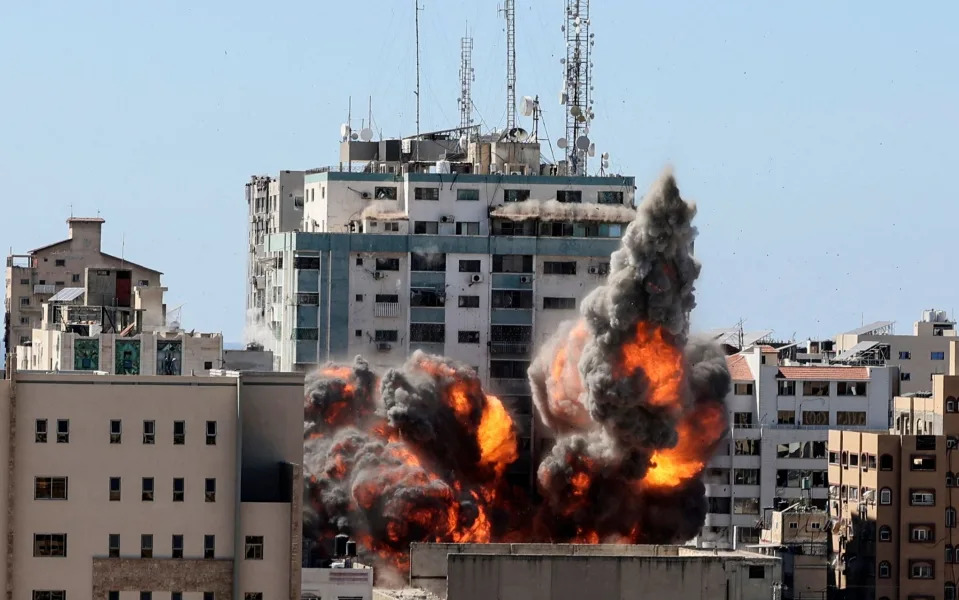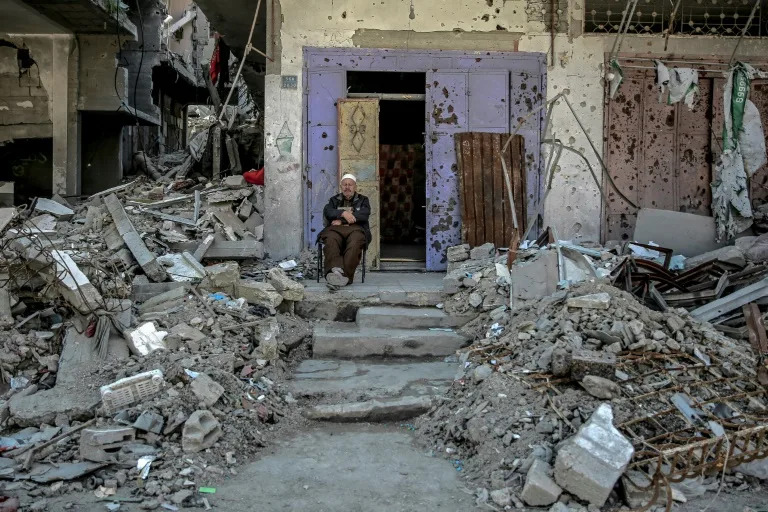The US is helping convert Israel’s bombs into precision weapons in an attempt to limit the heavy civilian casualties during its military campaign in Gaza.
High-tech Spice (smart precision impact cost effective) kits worth $320million (£252million), which allow unguided dumb bombs to hit their targets with a much higher degree of accuracy, are being sent to the Israel Defense Forces (IDF).
Although the IDF insists it avoids collateral damage where possible, Israel has been heavily criticised for the high civilian death toll in Gaza.
Bombs equipped with the guidance kits use a scene-matching algorithm to strike targets matching a pre-loaded image.
It can correct its trajectory if it is drifting off course and can operate in fog or darkness. It is not affected by GPS jamming equipment which can neutralise other guided weapons.
Analysis by CNN in December found that almost half of the air-to-ground munitions Israel has dropped in Gaza have been dumb bombs, which pose a greater risk to civilians.
Danger to Israeli pilots
The US believes the kits will also limit the danger to Israeli pilots, who have been forced to swoop low over their targets to aim more accurately.
The kit, which comprises a new nose cone and wing-like fins, fires a 1,000lb bomb at a range of up to 75 miles, or a 2,000lb bomb from 37 miles. They can also be used to hit slow-moving vehicles.
According to the Wall Street Journal, Rafael, an Israeli company with a branch in the US, that manufactures the kits, is transferring the equipment to its Israeli parent company for use by the IDF.
Israel’s conflict in Gaza, a densely populated area of roughly two million Palestinians, has exacted a heavy price on the civilian population over months of fighting.
Lloyd Austin, the US defence secretary, said that more than 25,000 civilians have been killed in Gaza since October, and called on Israel to do more to protect innocent lives.

There are fears of a humanitarian crisis if the IDF launches an offensive on Rafah, a city in southern Gaza. Its population has swollen to about one million people from Palestinians fleeing the conflict, but Israel believes it is the last stronghold of Hamas.
Rafael claims the weapons can hit targets with “minimum collateral damage”. However, experts believe the size of the bombs being dropped on Gaza means continued civilian casualties are inevitable.
Senior defence researcher J D Williams told the newspaper: “Any time you are doing military operations in a densely populated urban area, it’s very, very difficult to avoid not having collateral damage and not having great impacts on the civilian population.”
Shaan Shaikh, a defence analyst, said: “Regardless of guidance, if you drop a 2,000lb bomb on an area packed with civilians, on an area packed with critical infrastructure, you’re going to have a blast somewhere of 10 football fields.
“You’re going to have fragments and just pieces of debris going out hundreds, if not over a thousand feet.”
Gaza civilian deaths test Israel's AI precision claims
Israel says it only strikes military targets, and takes feasible measures to mitigate harm to civilians as far as possible.
The Israeli military has said AI helps it more accurately target militants in its five-month war against Hamas, but as Gaza deaths rise, experts are questioning how effective algorithms can really be.
The health ministry in the Hamas-run Gaza Strip says the war has killed upwards of 30,000 people, the majority of them civilians.
"Either the AI is as good as claimed and the IDF (Israeli military) doesn't care about collateral damage, or the AI is not as good as claimed," Toby Walsh, chief scientist at the University of New South Wales AI Institute in Australia, told AFP.
The health ministry does not specify how many militants are included in the Gaza toll.
Israel has said its forces "eliminated 10,000 terrorists" since the war began in early October, triggered by a deadly Hamas attack on southern Israel.
Israel's claimed use of algorithms adds another layer of concern for activists already alarmed by artificial intelligence-powered hardware like drones and gunsights that are being deployed in Gaza.
The Israeli military told AFP it had no comment on its AI targeting systems.
But the army has repeatedly claimed its forces target only militants and take measures to avoid harm to civilians.
- 'Precise attacks' -
Israel began hyping AI-powered targeting after an 11-day conflict in Gaza during May 2021, which commanders branded the world's "first AI war".
The military chief during the 2021 war, Aviv Kochavi, told Israeli news website Ynet last year that the force had used AI systems to identify "100 new targets every day".
"In the past, we would produce 50 targets in Gaza in a year," he said.
The current Gaza offensive began when Hamas launched an attack on October 7 that resulted in the deaths of about 1,160 people in Israel, mostly civilians, according to an AFP tally of official figures.
Weeks later, a blog entry on the Israeli military's website said its AI-enhanced "targeting directorate" had identified more than 12,000 targets in just 27 days.
An unnamed Israeli official was quoted as saying the AI system, called Gospel, produced targets "for precise attacks on infrastructure associated with Hamas, inflicting great damage on the enemy and minimal harm to those not involved".
But an anonymous former Israeli intelligence officer, quoted in November by independent Israeli-Palestinian publication +972 Magazine, described Gospel's work as creating a "mass assassination factory".
Citing an intelligence source, the report said Gospel crunches vast amounts of data faster than "tens of thousands of intelligence officers" and identifies, in real time, locations likely to be used by suspected militants.
However, the sources gave no detail of the data put into the system or the criteria used to determine the targets.
- 'Dubious data' -
Several experts told AFP the military was likely to be feeding the system with drone footage, social media posts, information from agents on the ground, mobile phone locations and other surveillance data.
Once the system identifies a target, it could use population data from official sources to estimate the likelihood of civilian harm.
But Lucy Suchman, professor of anthropology of science and technology at Britain's Lancaster University, said the idea that more data would produce better targets was untrue.
Algorithms are trained to find patterns in data that match a certain designation -- in the Gaza conflict, possibly "Hamas affiliate", she said.
Any pattern in the data matching a previously identified affiliate would generate a new target, but any "questionable assumptions" would be amplified, Suchman explained.
"In other words, more dubious data equals worse systems."
- Humans in control -
The Israelis are not the first fighting force to deploy automated targeting on the battlefield.
As far back as the 1990-91 Gulf War, the US military worked on algorithms to improve targeting.
For the 1999 Kosovo bombing campaign, NATO began using algorithms to calculate potential civilian casualties.
And the US military had hired secretive data firm Palantir to provide battlefield analytics in Afghanistan.
Backers of the technology have repeatedly insisted it will reduce civilian deaths.
But some military analysts are sceptical that the technology is advanced enough to be trusted.
In a blog post for the British Royal United Services Institute defence think-tank, analyst Noah Sylvia said last month that humans would still need to cross-check every output.
The Israeli military is "one of the most technologically advanced and integrated militaries in the world", he said.
But "the odds of even the IDF using an AI with such a degree of sophistication and autonomy are low".




